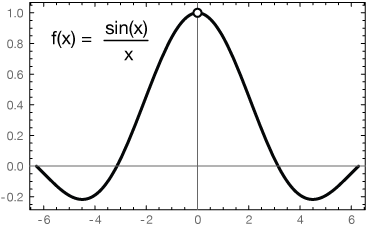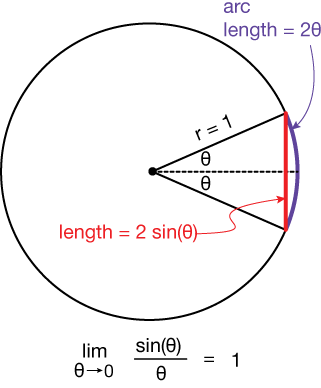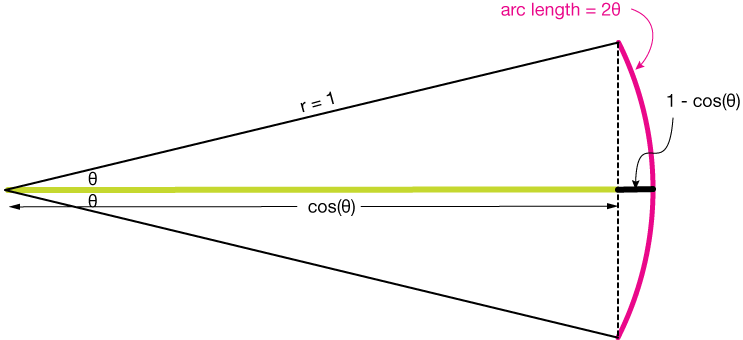This section is best understood after working through the section on general limits. You'll also need to be up to speed on your trigonometry, especially analytic trigonometry.
Limits of trigonometric functions
In this section we learn about two very specific but important trigonometric limits, and how to use them; and other tricks to find most other limits of trigonometric functions. The first involves the sine function, and the limit is
$$\lim_{x\to 0} \; \frac{\text{sin}(x)}{x} = 1$$
Here's a graph of $f(x) = \text{sin}(x)/x$, showing that it has a hole at $x = 0$. Our task in this section will be to prove that the limit from both sides of this function is 1.

The second limit involves the cosine function, specifically the function $f(x) = (\text{cos}(x) - 1)/x$:
$$\lim_{x\to 0} \; \frac{\text{cos}(x) - 1}{x} = 0$$
Here is a graph of that function, another well-behaved, smooth function except for the hole in its domain at $x = 0$.

These limits come up often in our studies of calculus and infinite series. They are essential for developing the derivatives of trig. functions, and because trig. functions are so important in physics and other fields, their derivatives are very important. You should
Below we'll use geometric and algebraic methods to prove that these limits actually are what they look like they are from their graphs.
Hole
A function has a hole in its graph when a single point is missing from the domain. Almost always, that value of the independent variable would make a denominator zero — make the function "blow up."
A hole in a rational function can often be identified by the same binomial (x - y) appearing in both the numerator and denominator, but that doesn't always have to be true for a hole to exist.
The sine limit — A geometric proof
$$\text{Proof that} \: \; \lim_{\theta \rightarrow 0} \, \frac{\text{sin}(\theta)}{\theta} = 1$$
Here is a geometric proof that the above limit is true.
Take a unit circle and mark out the angle $\theta$ above and below the dashed radius, for a total angle of $2\theta$. The length of the arc of a unit circle is the measure of the arc angle (in radians), so the length of the purple arc is $2\theta$. (You might want to refresh your memory on arc length in the section on circles.) Using some right-triangle trigonometry, the length of the straight red segment is $2 \, \text{sin}(\theta)$.
If we take a small enough segment of an arc, it closely resembles a straight line segment. The idea is that if we take any small-enough segment of a curve, it is approximately linear. As $\theta$ tends to zero, the length of the purple arc and the length of the red segment get closer to being equal, and the ratio closer to one. Notice that the line will always be smaller than the arc, so the value of the ratio will always be less than 1.

Here's a look at the effect of reducing $2\theta$ has on the ratio of the length of the arc to the length of the segment. In the center the angle has been reduced to half of its original size. On the right, it's been reduced again, and the figure has been enlarged to four times the size.

The $\text{sin}(x)/x$ limit is also proved in example 2 of the section on the squeeze theorem using – surprise – the squeeze theorem.
The cosine limit — an algebraic proof
$$\text{Proof that} \: \; \lim_{\theta \rightarrow 0} \, \frac{\text{cos}(\theta) - 1}{\theta} = 0$$
With the sine limit proof above in our quiver, we can prove this cosine limit algebraically. We begin by multiplying the limit by:
$$\frac{\text{cos}(\theta) + 1}{\text{cos}(\theta) + 1}$$
to get
$$\lim_{\theta\to 0} \frac{(\text{cos}(\theta) - 1)(\text{cos}(\theta) + 1)}{\theta \cdot (\text{cos}(\theta) + 1)}$$
Multiplying the binomials in the numerator gives
$$\lim_{\theta\to 0} \frac{\text{cos}^2(\theta) - 1}{\theta \cdot (\text{cos}(\theta) + 1)}$$
Now if we recall the Pythagorean identity, $\text{sin}^2(x)+\text{cos}^2(x)=1$, the numerator can be rewritten
(We're trying to move toward sine functions so we can use the sine limit we've already proved).
$$= \lim_{\theta \rightarrow 0} \, \frac{- \text{sin}^2 (\theta)}{\theta \cdot (\text{cos}(\theta) + 1)}$$
We can then break this expression into two parts, one of which is our sine limit, and the other which can be evaluated by direct substitution:
$$= \lim_{\theta \rightarrow 0} \, \frac{\text{sin}(\theta)}{\theta} \cdot \frac{-\text{sin}(\theta)}{\text{cos}(\theta) + 1} = 1 \cdot 0 = 0$$
Here we've invoked the multiplication property of limits,
$$\lim_{x \rightarrow c} f(x) \cdot g(x) = \left( \lim_{x \rightarrow c} f(x) \right) \left( \lim_{x \rightarrow c} g(x) \right)$$
By the way, my students often ask questions like "How would I know to multiply by cos(θ)+1 over itself?" Remember that it probably took the first person who worked on this a long time to discover that. We benefit from that work.
The cosine limit — a geometric proof
Using the figure below, we can also prove the cosine limit geometrically, though it's not quite as obvious as the sine limit. We start with a larger version of the unit circle (only a sector of angle $2\theta$ is shown). Taking the radius as $r = 1$ and subtracting $\text{cos}(\theta)$, which is the length of the green line, we have the length of the segment that spans the gap between the chord and the sector arc, $1-\text{cos}(\theta)$. As angle $\theta$ shrinks (approaches zero), so does the length of the black segment.

Now $1-\text{cos}(\theta)$ is just the negative of $\text{cos}(\theta)-1$, the numerator of our limit. At very small angles this distance approaches zero because the cosine function is fairly flat and close to 1 in the vicinity of $\theta=0$.
Example 1
Find the limit:
$$\lim_{x \rightarrow 0} \, \frac{\text{sin}(5x)}{x}$$
$$u = 5x \: \: \color{#E90F89}{\longrightarrow} x = \frac{u}{5}$$
Now our new limit, as $u \rightarrow 0$, is
$$= \lim_{u \rightarrow 0} \, \frac{\text{sin}(u)}{u/5}$$
Now this is really just our $\text{sin}(x)/x$ limit divided by $\frac{1}{5}$ (which means multiplied by 5). The rules of algebra of limits tell us that we can move that $\frac{1}{5}$ out in front of the limit like this:
$$= 5 \cdot \lim_{u \rightarrow 0} \, \frac{\text{sin}(u)}{u} = 5$$
Example 2
Find the limit:
$$\lim_{x \rightarrow 0} \, \frac{1 - \text{cos}(x)}{\text{sin}(x)}$$
$$= \lim_{x \rightarrow 0} \left( \frac{1 - \text{cos}(x)}{\text{sin}(x)} \right) \left( \frac{1 + \text{cos}(x)}{1 + \text{cos}(x)} \right)$$
If we multiply the numerator (we'll just leave the denominator for now — you don't always want to rush your algebra — we get
$$= \lim_{x \rightarrow 0} \frac{1 - \text{cos}^2(x)}{(\text{sin}(x))(1 + \text{cos}(x))}$$
Now by the Pythagorean identity of trigonometry, the numerator is just $\text{sin}^2(x)$, so we have a new limit that can easily be evaluated:
$$ \begin{align} &= \lim_{x \rightarrow 0} \frac{\text{sin}^2(x)}{(\text{sin}(x))(1 + \text{cos}(x))} \\[8pt] &= \lim_{x \rightarrow 0} \frac{\text{sin}(x)}{1 + \text{cos}(x)} = 0 \end{align}$$
Example 3
Find the limit:
$$\lim_{x \rightarrow 0} \frac{\text{sin}(3x)}{\text{sin}(5x)}$$
$$= \lim_{x \rightarrow 0} \left( \frac{\text{sin}(3x)}{\text{sin}(5x)} \right) \left( \frac{x}{x} \right)$$
Then split this expression into a product of two
$$= \lim_{x \rightarrow 0} \left( \frac{\text{sin}(3x)}{x} \right) \left( \frac{x}{\text{sin}(5x)} \right)$$
Now express the second term to the -1 power.
$$= \lim_{x \rightarrow 0} \left( \frac{\text{sin}(3x)}{x} \right) \left( \frac{\text{sin}(5x)}{x} \right)^{-1}$$
Now from example 1 above, we know these limits, and the rest is pretty easy.
$$= \left( \lim_{x \rightarrow 0} \, \frac{\text{sin}(3x)}{x} \right) \left( \lim_{x \rightarrow 0} \frac{\text{sin}(5x)}{x} \right)^{-1} = \frac{3}{5},$$
where the limit in the first parentheses is 3 and the second is 5-1.
Practice problems
Find the following limits. The trick is to get them to look like one (or a combination of) our two main limits above.
-
$$\lim_{x \rightarrow 0} \, \frac{\text{sin}(6x)}{6x}$$
Solution
$$= \frac{1}{6} \, \lim_{x \rightarrow 0} \, \frac{\text{sin}(6x)}{x}$$
Let u = 6x, then $x = \frac{u}{6}:$
$$ \begin{align} &= \frac{1}{6} \, \lim_{u \rightarrow 0} \, \frac{\text{sin}(u)}{u/6} \\[5pt] &= \frac{6}{6} \, \frac{\text{sin}(u)}{u} = 1 \cdot 1 = 1 \end{align}$$
-
$$\lim_{x \rightarrow 0} \, \frac{\text{sin}(4x)}{\text{sin}(5x)}$$
Solution
Multiply by x/x:
$$ \begin{align} &= \lim_{x \rightarrow 0} \, \frac{\text{sin}(4x)}{x} \cdot \frac{x}{\text{sin}(5x)} \\[5pt] &= \lim_{x \rightarrow 0} \, \frac{\text{sin}(4x)}{x} \left( \lim_{x \rightarrow 0} \, \frac{\text{sin}(5x)}{x} \right)^{-1} \\[5pt] &= 4 \cdot 5^{-1} = \frac{4}{5} \end{align}$$
-
$$\lim_{x \rightarrow 0} \, \frac{\text{tan}(3x)}{\text{sin}(x)}$$
Solution
Convert to sines and cosines:
$$= \lim_{x \rightarrow 0} \frac{\text{sin}(3x)}{\text{sin}(x) \text{cos}(3x)}$$
Multiply by x/x:
$$ \begin{align} &= \lim_{x \rightarrow 0} \frac{\text{sin}(3x)}{x} \cdot \left( \frac{\text{sin}(x)}{x} \right)^{-1} \cdot \frac{1}{\text{cos}(3x)} \\[5pt] &= 3 \cdot 1 \cdot 1 = 3 \end{align}$$
-
$$\lim_{x \rightarrow 0} \, \frac{\text{cos}(x) - 1}{\text{sin}(x)}$$
Solution
$$ \begin{align} &= \lim_{x \rightarrow 0} \left( \frac{\text{cos}(x) - 1}{\text{sin}(x)} \right) \frac{x}{x} \\[5pt] &= \lim_{x \rightarrow 0} \frac{\text{cos}(x) - 1}{x} \cdot \lim_{x \rightarrow 0} \left( \frac{\text{sin}(x)}{x} \right)^{-1} \\[5pt] &= 0 \, \cdot \, 1 = 0 \end{align}$$
-
$$\lim_{x \rightarrow 0} \, \frac{\text{sin}^2 (5x)}{x^2}$$
Solution
$$ \begin{align} &= \lim_{x \rightarrow 0} \left( \frac{\text{sin}(5x)}{x} \right)^2 \\[5pt] &= \left( \lim_{x \rightarrow 0} \frac{\text{sin}(5x)}{x} \right)^2 \\[5pt] &= 5^2 = 25 \end{align}$$
-
$$\lim_{x \rightarrow 0} \, \frac{\text{sin}(x)}{x \, \text{tan}(x)}$$
Solution
$$ \begin{align} &= \lim_{x \rightarrow 0} \frac{\text{sin}(x)}{\frac{x \, \text{sin}(x)}{\text{cos}(x)}} \\[5pt] &= \lim_{x \rightarrow 0} \frac{\text{sin}(x) \text{cos}(x)}{x \, \text{sin}(x)} \\[5pt] &= \lim_{x \rightarrow 0} \frac{\text{cos}(x)}{x} \rightarrow \infty \end{align}$$
-
$$\lim_{x \rightarrow 0} \frac{\text{sin}(x^2)}{x}$$
Solution
Let $u = x^2,$ then $x = u^{1/2}.$ Now convert to u's and multiply by $u^{1/2}/u^{1/2}:$
$$ \begin{align} &\rightarrow \lim_{u \rightarrow 0} \frac{\text{sin}(u)}{u^{1/2}} \frac{u^{1/2}}{u^{1/2}} \\[5pt] &= \lim_{u \rightarrow 0} \, \frac{u^{1/2} \text{sin}(u)}{u} \\[5pt] &= \lim_{u \rightarrow 0} u^{1/2} \cdot \lim_{u \rightarrow 0} \frac{\text{sin}(u)}{u} \\[5pt] &= 0 \; \cdot \; 1 = 0 \end{align}$$
-
$$\lim_{x \rightarrow \frac{\pi}{4}} \, \frac{1 - \text{tan}(x)}{\text{sin}(x) - \text{cos}(x)}$$
Solution
$$ \begin{align} &\lim_{x \rightarrow \frac{\pi}{4}} \frac{1 - \frac{\text{sin}(x)}{\text{cos}(x)}}{\text{sin}(x) - \text{cos}(x)} \\[5pt] &= \lim_{x \rightarrow \frac{\pi}{4}} \frac{\frac{\text{cos}(x) - \text{sin}(x)}{\text{cos}(x)}}{\text{sin}(x) - \text{cos}(x)} \\[5pt] &= \lim_{x \rightarrow \frac{\pi}{4}} \frac{\text{cos}(x) - \text{sin}(x)}{-\text{cos}(x)[\text{cos}(x) - \text{sin}(x)]} \\[5pt] &= \lim_{x \rightarrow \frac{\pi}{4}} \frac{1}{-\text{cos}(x)} \\[5pt] &= \frac{-2}{\sqrt{2}} = -\sqrt{2} \end{align}$$
-
$$\lim_{x \rightarrow 0} \, \frac{\text{sin}(x - 1)}{x^2 + x - 2}$$
Solution
Let $u = x - 1,$ then $x = u + 1.$ Now convert to u's:
$$ \begin{align} &\lim_{u \rightarrow 0} \frac{\text{sin}(u)}{u^2 + 4u + 1 + u + 1 - 2} \\[5pt] &= \lim_{u \rightarrow 0} \frac{\text{sin}(u)}{u^2 + 5u} \\[5pt] &= \lim_{u \rightarrow 0} \frac{\text{sin}(u)}{u (u + 5)} \\[5pt] &= \lim_{u \rightarrow 0} \frac{\text{sin}(u)}{u} \cdot \lim_{u \rightarrow 0} \frac{1}{u + 5} \\[5pt] &= 1 \; \cdot \ \frac{1}{5} = \frac{1}{5} \end{align}$$

![]()
xaktly.com by Dr. Jeff Cruzan is licensed under a Creative Commons Attribution-NonCommercial-ShareAlike 3.0 Unported License. © 2012-2025, Jeff Cruzan. All text and images on this website not specifically attributed to another source were created by me and I reserve all rights as to their use. Any opinions expressed on this website are entirely mine, and do not necessarily reflect the views of any of my employers. Please feel free to send any questions or comments to jeff.cruzan@verizon.net.